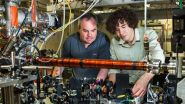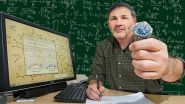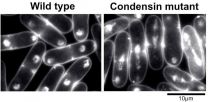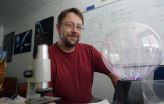(Press-News.org) The bizarre nature of reality as laid out by quantum theory has survived another test, with scientists performing a famous experiment and proving that reality does not exist until it is measured.
Physicists at The Australian National University (ANU) have conducted John Wheeler's delayed-choice thought experiment, which involves a moving object that is given the choice to act like a particle or a wave. Wheeler's experiment then asks - at which point does the object decide?
Common sense says the object is either wave-like or particle-like, independent of how we measure it. But quantum physics predicts that whether you observe wave like behavior (interference) or particle behavior (no interference) depends only on how it is actually measured at the end of its journey. This is exactly what the ANU team found.
"It proves that measurement is everything. At the quantum level, reality does not exist if you are not looking at it," said Associate Professor Andrew Truscott from the ANU Research School of Physics and Engineering.
Despite the apparent weirdness, the results confirm the validity of quantum theory, which governs the world of the very small, and has enabled the development of many technologies such as LEDs, lasers and computer chips.
The ANU team not only succeeded in building the experiment, which seemed nearly impossible when it was proposed in 1978, but reversed Wheeler's original concept of light beams being bounced by mirrors, and instead used atoms scattered by laser light.
"Quantum physics predictions about interference seem odd enough when applied to light, which seems more like a wave, but to have done the experiment with atoms, which are complicated things that have mass and interact with electric fields and so on, adds to the weirdness," said PhD student Roman Khakimov.
Professor Truscott's team first trapped a collection of helium atoms in a suspended state known as a Bose-Einstein condensate, and then ejected them until there was only a single atom left.
The single atom was then dropped through a pair of counter-propagating laser beams, which formed a grating pattern that acted as crossroads in the same way a solid grating would scatter light.
A second light grating to recombine the paths was randomly added, which led to constructive or destructive interference as if the atom had travelled both paths. When the second light grating was not added, no interference was observed as if the atom chose only one path.
However, the random number determining whether the grating was added was only generated after the atom had passed through the crossroads.
If one chooses to believe that the atom really did take a particular path or paths then one has to accept that a future measurement is affecting the atom's past, said Truscott.
"The atoms did not travel from A to B. It was only when they were measured at the end of the journey that their wave-like or particle-like behavior was brought into existence," he said.
INFORMATION:
http://www.nature.com/nphys/journal/vaop/ncurrent/full/nphys3343.html END
An international team of scientists studying ultrafast physics have solved a mystery of quantum mechanics, and found that quantum tunneling is an instantaneous process.
The new theory could lead to faster and smaller electronic components, for which quantum tunneling is a significant factor. It will also lead to a better understanding of diverse areas such as electron microscopy, nuclear fusion and DNA mutations.
"Timescales this short have never been explored before. It's an entirely new world," said one of the international team, Professor Anatoli Kheifets, from The ...
This news release is available in Japanese.
Right before a cell starts to divide to give birth to a daughter cell, its biochemical machinery unwinds the chromosomes and copies the millions of protein sequences comprising the cell's DNA, which is packaged along the length of the each chromosomal strand. These copied sequences also need to be put back together before the two cells are pulled apart. Mistakes can lead to genetic defects or cancerous mutations in future cell generations.
Just like raising a building requires scaffolding be erected first, cells ...
The method used to calculate Standard & Poor's Case-Shiller Home Price Indices, the most trusted benchmark for U.S. residential real estate prices, contains a flaw that likely could lead to misstating its monthly estimates, according to a newly published study led by faculty at Florida Atlantic University.
The paper published in the Journal of Real Estate Research identifies an important deficiency in the Weighted Repeated Sales (WRS) method developed by economists Karl Case and Robert Shiller, which compares repeat sales of the same homes in an effort to study home ...
Anti-osteoporotic medication is not an effective means for preventing hip fractures among the elderly, concludes a study recently published in the BMJ.
Proximal femoral fractures (i.e., hip fractures) occur in the world at a rate of 1.5 million per year, or 7,000 per year in Finland. As most such fractures occur among older people, their number is expected to grow as the population ages. Hip fractures often lead to permanently reduced mobility, quality of life and general health, as well as result in significant social costs.
Since the early 1990s, anti-osteoporotic ...
The teacher's interaction style can either foster or slow down the development of math skills among children with challenging temperaments. This was shown in the results of the study "Parents, teachers and children's learning" carried out at the University of Jyväskylä, Finland.
Ph.D. Jaana Viljaranta, along with her colleagues, studied the role of teachers' interaction styles in academic skill development among children with different temperamental characteristics.
A child's challenging temperament may show up in the classroom, for example, as low task-orientation ...
When Niels Bohr hypothesised his model of atom with the electrons orbiting the nucleus just like satellites orbit a planet, he was engaging in analogical reasoning. Bohr transferred to atoms the concept of "a body orbiting another", that is, he transferred a relation between objects to other, new objects. Analogical reasoning is an extraordinary ability that is unique to the human mind, is not seen in animals (except very rarely in primates) and that forms the basis of highly sophisticated human thoughts. Scientists have wondered about the origin of this cognitive function: ...
Jena (Germany) March 1938: The Italian elementary particle physicist Ettore Majorana boarded a post ship in Naples, heading for Palermo. But he either never arrives there - or he leaves the city straight away - ever since that day there has been no trace of the exceptional scientist and until today his mysterious disappearance remains unresolved. Since then, Majorana, a pupil of the Nobel Prize winner Enrico Fermi, has more or less been forgotten. What the scientific world does remember though is a theory about nuclear forces, which he developed, and a very particular elementary ...
Hodgkin's lymphoma--cancer of the lymph nodes--arises in more than 150 children and adolescents in Germany each year. Nine out of ten patients survive the disease, thanks to the highly effective treatments that are now available. Depending on the type of treatment given, however, there may be late sequelae, as discussed by Wolfgang Dörffel and colleagues in an original article in the current issue of Deutsches Ärzteblatt International (Dtsch Arztebl Int 2015; 112: 320-7). These authors studied the question of which types of treatment were more likely to be followed ...
An international team of researchers has for the first time predicted the occurrence of aurorae visible to the naked eye on a planet other than Earth.
Mars' upper atmosphere may be indeed closer to Earth's than previously thought. Researchers showed that the upper atmosphere of Mars glows blue depending on the activity of the Sun. The result was achieved through numerical simulation and a laboratory experiment, called the Planeterrella, used to simulate the aurora. The study was published in the leading planetology publication Planetary and Space Science on 26 May.
'The ...
GAINESVILLE, FL -- As the container nursery industry faces severe restrictions on water use, researchers are looking to identify ways to minimize watering needs and eliminate excess watering. The authors of a new study say that understanding container-grown plants' capacity to "capture" sprinkler irrigation water can give growers important tools that help them adjust irrigation rates, reduce water use, and produce healthy plants.
Jeff Million and Thomas Yeager from the Department of Environmental Horticulture at the University of Florida say that there has been limited ...




